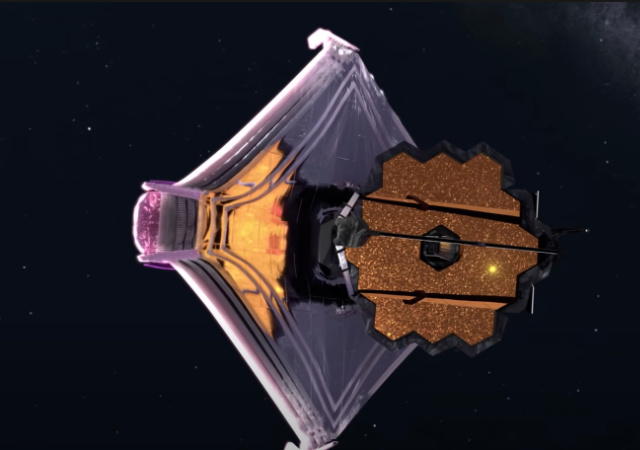James Webb Telescope Launches on Christmas Day, Swings by Moon on Tuesday Morning
Telescope will reach its final destination in 29 days, after a series of complex steps and maneuvers.

The last time we checked in on the new James Webb Space Telescope, it was being moved to its launch site after the National Aeronautics and Space Administration (NASA) rejected the demands of LGBTQ activists and diversity-inclusion minions to change the name due to trumped-up charges of “homophobia.”
The telescope successfully launched on Christmas Day.
The massive observatory launched today (Dec. 25) from Europe’s Spaceport in Kourou, French Guiana, at 7:20 a.m. EST (1220 GMT). Just 12.5 hours later, the spacecraft began a vital maneuver on its month-long journey to its future outpost as the observatory executed a 65-minute-long thruster burn that concluded at 8:55 p.m. EST (0155 GMT), according to a statement from NASA.
The space telescope is destined to orbit a point in space known as Earth-sun Lagrange point 2 or L2, which is located nearly 1 million miles (1.5 million kilometers) away from Earth on the opposite side as the sun. The spacecraft covered the first 10% of that journey within 12 hours of launching. Then, when the telescope was about 100,000 miles (160,000 km) away from Earth, the observatory executed a crucial burn to ensure it would safely reach its destination.
The telescope raced past the moon on Tuesday morning.
It’s been a busy evening! Not only did we just complete our second burn, but #NASAWebb also passed the altitude of the Moon as it keeps cruising on to the second Lagrange point to #UnfoldTheUniverse. Bye, @NASAMoon! 👋 🌑 pic.twitter.com/IStul0fwFB
— NASA Webb Telescope (@NASAWebb) December 28, 2021
We thought we felt a breeze!
Kidding, of course, but good luck on the rest of your journey to L2, @NASAWebb! 👋🌌
Where is Webb? https://t.co/MShpQnHfvX https://t.co/JosaTYSmEX
— NASA Moon (@NASAMoon) December 28, 2021
The telescope is named for the NASA administrator who led the space agency through the early years of the Apollo program. It is more powerful and sophisticated than the Hubble Space Telescope that has already generated a wealth of information and iconic imagery.
Its primary light gathering mirror is 21 feet across, about three times bigger than Hubble, and seven times more sensitive.
The Webb’s mission is to seek out the earliest, most distant stars and galaxies, which appeared 13.7 billion years ago, burning their way out of a fog leftover from the Big Bang (which occurred 13.8 billion years ago).
Astronomers watching the launch remotely from all over the world, many Zooming together in their pajamas, were jubilant.
“What an incredible Christmas present,” said Garth Illingworth of the University of California, Santa Cruz.
As noted above, the telescope is now headed for the Sun-Earth Lagrange Point 2 (L2), a gravitationally stable spot 930,000 miles Earth in the direction of Mars. The flight there will take 29 days, with key steps and important maneuvers.
One day after launch, Webb will rotate its high-gain antenna toward Earth to further facilitate communications with its handlers. A day after that, the spacecraft will perform another engine burn to refine its trajectory toward L2. And three days after launch, the pallet holding Webb’s huge sunshield — a five-layer structure designed to keep the infrared telescope and its instruments cool — will be lowered.
Each of the shield’s five sheets is about the size of a tennis court when fully extended, far too wide to fit inside the payload fairing of any currently operational rocket. So the sunshield launched in a compact configuration and must be unfurled.
…At around 10 days after launch, Webb will extend its 2.4-foot-wide (0.74 meters) secondary mirror, which is so named because it’s the second surface that deep-space photons will hit on their way to the scope’s instruments.
It will then be time for Webb’s 21.3-foot-wide (6.5 m) primary mirror to shine. That mirror, which is composed of 18 hexagonal segments, launched folded up, as the sunshield did. Twelve to 13 days after launch, the mirror’s two side “wings” will extend and lock into place, giving the surface its full size.
I am looking forward to all the fun, new data, and discoveries that I will be sharing with you.
 DONATE
DONATE
Donations tax deductible
to the full extent allowed by law.









Comments
The intro has the feel of Bab 5 themes.
If they had hired (2004) Galactica’s drummer.
…and as it sails over the mesa in the Sea of Tranquility it focuses it’s cameras on an unusual spot situated near the rim of a crater. Zooming in, Mission Control sees a large banner come into focus, upon which a huge likeness of George Sink is printed along with **sink
Sounds fantastic – I hope everything deploys as they intend (I am thinking of Curiosity which was such an amazing feat).
I too look forward to much more about this telescope.
One small correction. From my old days in the L5 Society, I vaguely remember L1, L2, and L3 are *un* stable orbits, its just that it can take months to years for an object placed in one to move out of place. Minor corrections will be needed every once in a while to rebalance the orbit, but *very* minor depending on how carefully it is put in place and maintained. The L2 point in question is the Earth-SUN point, which is way, way, way out there compared to the Earth-Moon L2 point (which is where I thought it was at first, and wondered how we would be able to talk to it) Presumably they didn’t want to park it in L4 or L5 (Either Earth/Sun or Earth/Moon) because there are rocks lurking there too and the last thing they want is a handful of gravel constantly bumping gently into every nook and cranny of their multi-billion dollar widget. NASA has a nice chart here.
https://webb.nasa.gov/content/about/orbit.html